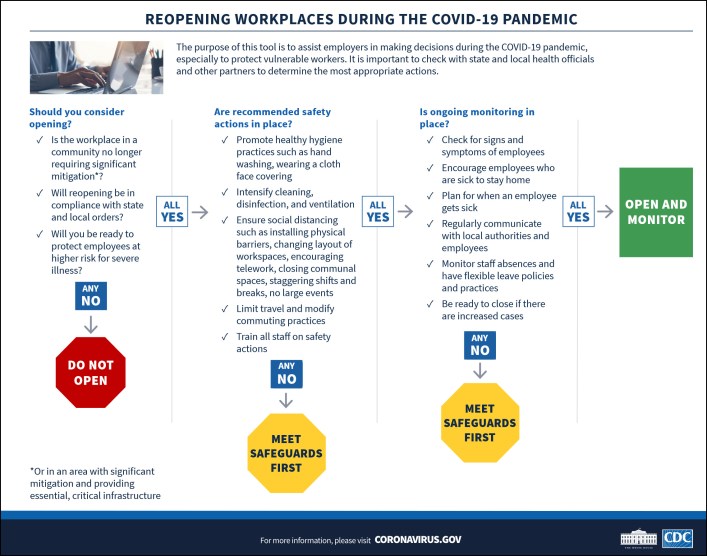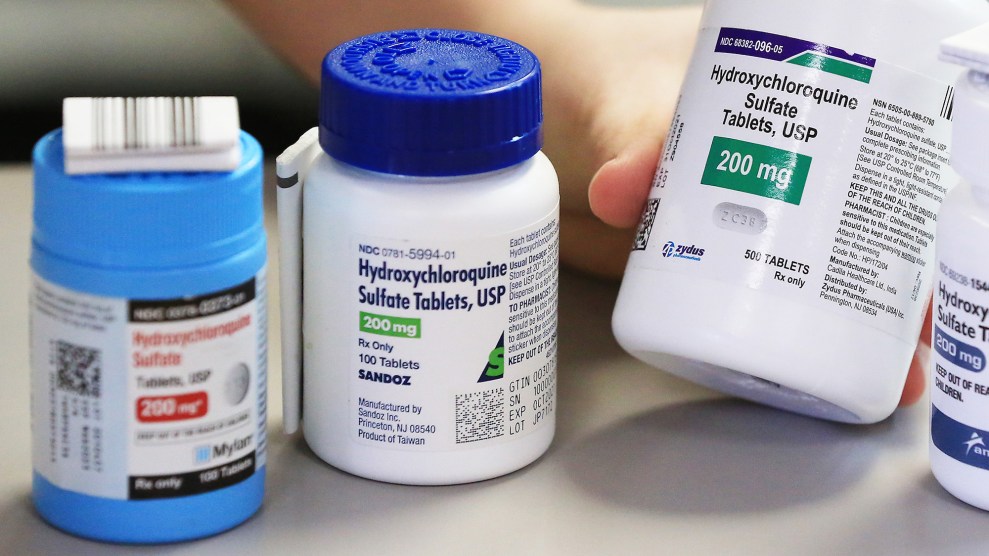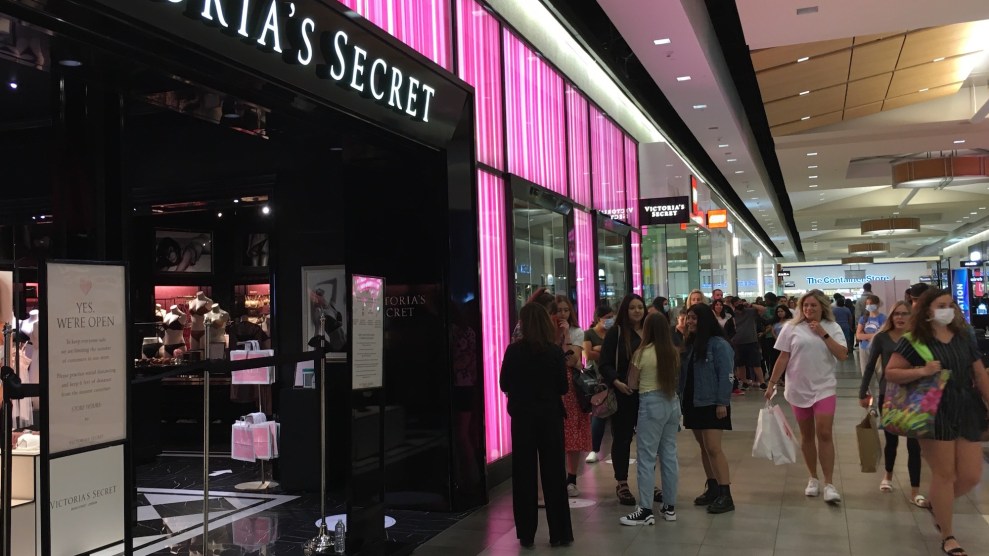
Shoppers line up to enter Victoria's Secret at the Fashion Place Mall in Utah, June 6, 2020.Stephanie Mencimer/Mother Jones
It’s hard to take the pandemic lightly when you live in Washington, DC. In this town of news junkies and rule followers, there are unpaid enforcers of Mayor Muriel Bowser’s coronavirus countermeasures lurking on every sidewalk—6 feet away, of course. “Where’s your mask?” screamed a neighbor when I was walking the 5 feet from home to my car one day.
It took a trip to Utah for me to feel these same compulsions. On Saturday, my daughter and I waited in a line at the Sunglass Hut at the Fashion Place mall just outside of Salt Lake City. There were only two people in front of us, and a sign at the door restricted shopping to four people at a time and requested that customers wear marks. We dutifully filed in 6 feet behind the other waiting customers, but people quickly started to congregate behind us like we were in line for a Kiss concert at the Salt Palace. We scooted forward and they just kept moving closer. The couple pressing up behind us made out to pass the time, something masks would obviously interfere with.
The scene at Sunglass Hut was just one of many indications that we’d moved from what felt like the mainstream to an alien spot along the continuum of America’s coronavirus consciousness. After three months of being locked down in DC because of the pandemic, I had come to Utah, where I was born and raised, with my daughter to escape a summer of ennui. We were trading online summer camp and Zoom visits for big sky country and socially distanced walks with my parents. We thought the flight out would be the scariest part of our trip to a state that, at the time we bought our tickets, had very few cases of COVID-19. But by the time we left DC, where the infection rate was falling, Utah was in the midst of a sustained spike in infections after largely allowing the economy to reopen without restrictions in early May. The day we headed to the mall, the state reported 546 new cases, a Utah record. Our shopping trip made it clear why.
We went to Fashion Place trying to remedy an unexpected problem created by the lockdowns in DC. When our home town shut down all nonessential businesses back in mid-March, it was 40 degrees out. By the time we left for Utah in June, Washington’s summer weather had appeared, and it was 90 degrees. Plus, my daughter had grown 3 inches since last summer. She desperately needed some shorts, but our attempts to order clothes online had failed. So when we got to Utah, where stores have been open since May 5, we naïvely thought we could don our KN95 masks, zip into H&M, and grab some essentials in much the same way we bought milk at Whole Foods.
The packed parking lot should have been our first clue that this was a terrible idea. We hadn’t eaten in a restaurant or shopped in a store that wasn’t a supermarket since March. We had become accustomed to waiting outside on designated spots painted on the sidewalk six feet apart, with security guards at the door limiting admission and insuring everyone was wearing a mask. Physical barriers ensured that one-way shopping cart traffic was strictly enforced.
Which is all to say, we were utterly unprepared for the free-for-all at a mall 2,000 miles away.
“We fully anticipated that as we started to loosen restrictions you would see cases increase,” state health department communications director Tom Hudachko told me in an interview, acknowledging that the mall scene is not what the department was hoping for. “Certainly, we feel like maybe people have let their guards down a little too much at this point.”
Walking through the doors of Dillard’s on Saturday was like going back in time. People were browsing racks of shirts, huddling over jewelry cases, and pushing past us to check out the latest shoe sales like it was Christmas 2019. Few customers wore masks, and no one was social distancing. For about two minutes, my daughter and I, both wearing masks, half-heartedly looked at summer sandals, and then, panicked by the crowds, fled back out to the parking lot.
Outside, we gathered our composure and decided to try again. When we attempted to access H&M from an outdoor entrance, we ran smack into a long line of people clumped together waiting to eat Factory Nachos at an indoor table at the Cheesecake Factory. Yes, an indoor table, which people in hard hit cities like New York and DC are unlikely to see for months. The H&M door was closed, so we had to go through the main mall entrance, where we were met with nothing more than a sad looking hand sanitizer dispenser and a chirpy sign telling us to “feel safe, shop happy.”
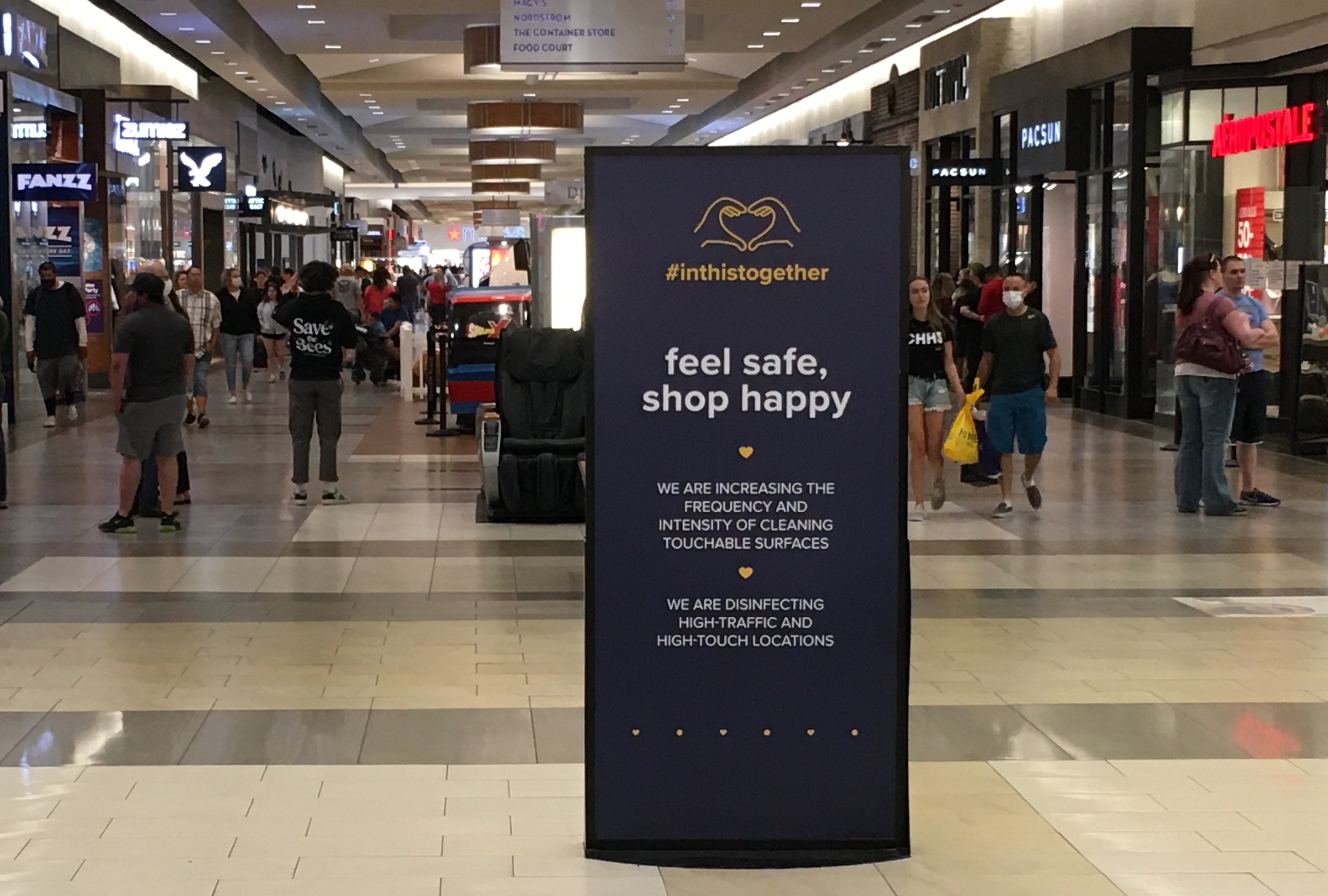
The scene inside was a haphazard implementation of Republican Gov. Gary Herbert’s reopening recommendations from May that people wear masks and businesses enforce social distancing. But these were only recommendations, not requirements.
Some stores were still closed, like the jewelry store and the Build-a-Bear (sorry kids). Others were wide open, with people coming and going freely and milling around inside. At Victoria’s Secret, there must have been 40 people lined up shoulder to shoulder at the entrance waiting to peruse panties and try on bustiers. The store was limiting occupancy inside, an attempt at enforcing social distancing that was all but defeated by the crowd assembled in the mall corridor. We found a similar scene at H&M, which had closed off all the entrances but one, inside the mall, forcing customers into another bottleneck.
We gave up on the shorts and ventured instead to the Sunglass Hut, where we thought maybe we could find my daughter a pair of badly needed sunglasses. Corporate policy demanded that customers wear masks, but the burden for enforcing that preventive measure lay with the single employee inside, who was unlikely to engage in such a confrontational task clearly above his pay grade. Once inside the store, the first pair of shades we picked up cost a prohibitive $400. With no stomach for bargain hunting, we fled once again to the great outdoors.
But first, we made a quick loop through the food court to see if we might be able to score a lemonade from Hot Dog on a Stick, an outpost of the fast-food joint I’d worked for in high school. A California chain, it was closed. But lots of other eateries were open and doing booming business. The food court tables had been set a few feet farther apart than usual, but customers had pushed some together, and large, carefree families were happily noshing on Chik-fil-A. We dashed outside and relished the fresh air—and a squirt of hand sanitizer. “I don’t think I’ll feel comfortable doing that for about three years,” my daughter said.
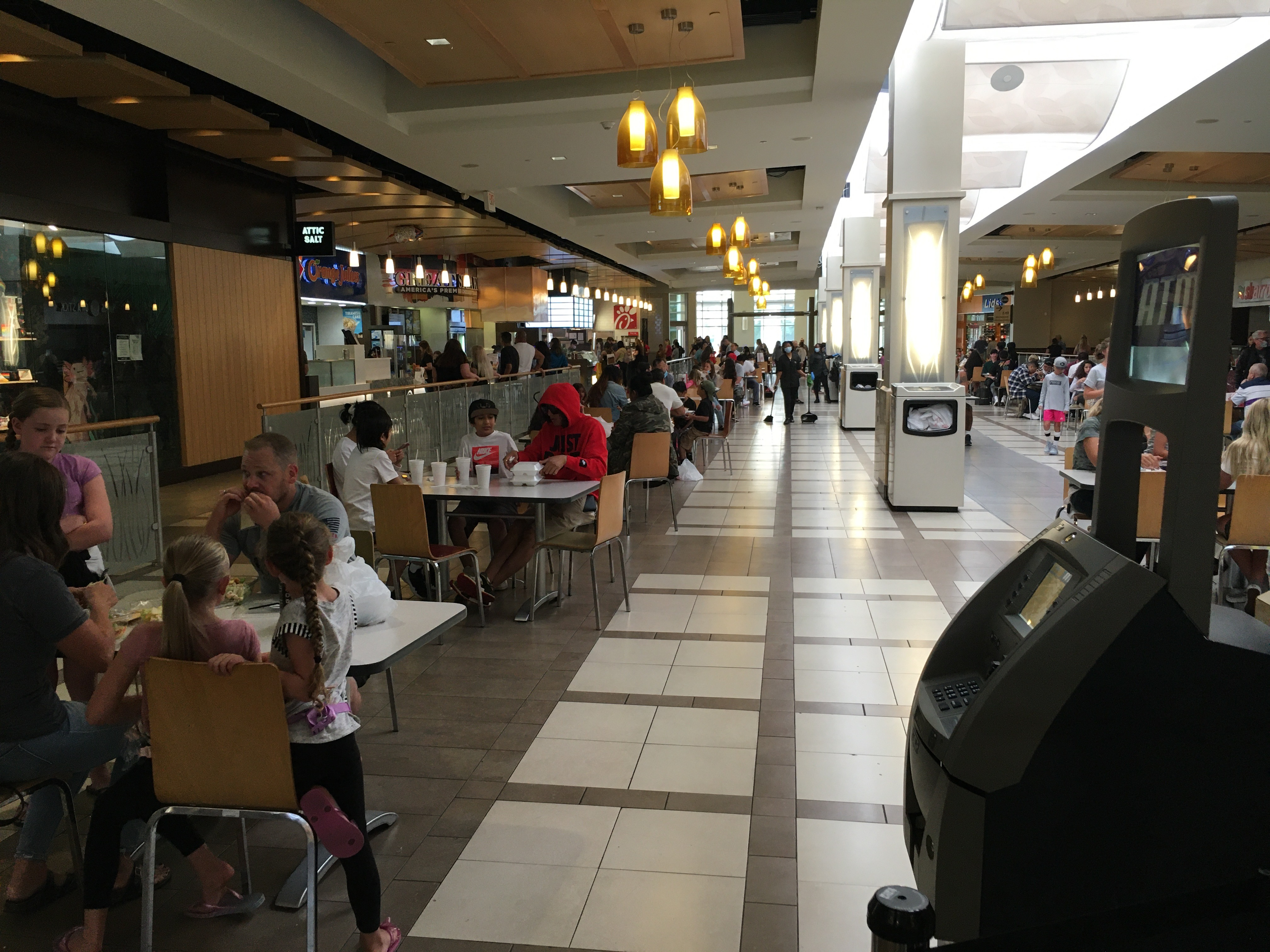
Stephanie Mencimer/Mother Jones
The mall was our first taste of the parallel universe that is taking place throughout the country. We’d gone from an East Coast city where people were constantly shouting at us for coming too close on the sidewalk to one in the West, where people seemed to have declared the pandemic over. But it isn’t over, and perhaps not surprisingly, Utah is now a hotspot for new infections. By June 10, Utah’s rate of positive tests was rising faster than almost any other state and the number of virus-related hospitalizations had jumped 17 percent just since Memorial Day. A third of the new cases were traced back to a meatpacking plant in Cache County, but the rest have been widely distributed. Even Jon Huntsman, the former Republican governor who’s running for his old job this year, tested positive for the virus this week.
The cavalier attitude of Utah residents about social distancing was on display early on during the pandemic. At the end of March, as other countries started to close their borders and the US contemplated more travel restrictions, the LDS church chartered five Boeing 777s to bring 1,600 Mormon missionaries back from the Philippines. Nine hundred of them arrived at the Salt Lake airport. In a state where more than 60 percent of residents are LDS, the arrival of returned missionaries is a huge deal. Before 9/11, large Mormon families would descend upon the airport en masse, crowding right up to the airline gates with balloons and signs, welcoming home their loved ones. After 9/11, security requirements put an end to the gate festivities, so the welcome wagon just moved to the baggage claim downstairs.
With the novel coronavirus prompting the return of all those overseas missionaries, church officials anticipated the airport reunion problem. They issued strict guidelines to families warning them not to congregate at baggage claim. Only two people could pick up a missionary, and they had to stay in the car. The church instructed missionaries to quarantine for 14 days before coming into contact with the wider family and the rest of the world. Instead, hundreds of Mormons gathered in the airport parking garage, and the missionaries pulled off their masks to greet family and girlfriends with hugs and kisses.
Hundreds of missionaries from the Philippines are coming back to Salt Lake City today. Social distancing is out the window as people welcome back their family members with posters, balloons, and hugs. @KUTV2News pic.twitter.com/CeyRDtRv9x
— Kelly Vaughen (@KellyVaughen) March 22, 2020
Horrified health department and other state officials issued a stern rebuke to the families. “Those types of gatherings cannot be happening. That will cause the spread of COVID-19,” state epidemiologist Angela Dunn told the Salt Lake Tribune. “We’re in this for the long haul. These social distancing measures will have to be a way of life.” Of course, as we saw at the mall more than two months later, despite 110,000 deaths in the US from the virus, social distancing never really took hold here.
Utah is a young state, with 30 percent of its population under the age of 18, a factor that may have spared it from worse outcomes from the virus, which disproportionately affects the elderly. As of Wednesday, the state had seen 128 deaths, mostly among people over 70. Nicholas Rupp, the communications manager from the Salt Lake County health department told me that the airport reunion didn’t result in the feared outbreak. “We did ask in contact tracing interviews if people attended an airport welcome home. We did not find any exposures with that circumstance,” he explained. “That’s not to say it was OK to do.”
As one of only nine states that did not impose a statewide shelter-in-place order, and like many red states, Utah never really embraced the idea of staying home to flatten the curve. Instead, in late March, Governor Herbert, who has been in office since 2009, issued a toothless state-wide stay-at-home directive that expired May 1 and did little more than require restaurants to end dine-in service. Schools were closed, but Herbert left most decisions about stricter lockdowns to local governments. The response varied widely.
Salt Lake County, with a population of more than 1 million, accounts for about half of the state’s nearly 13,000 cases, and, as a result, it closed all non-essential businesses in March. But Utah County, home to Provo and Brigham Young University, never issued one and instead let businesses decide for themselves how and whether to remain open. BYU shut down, but lots of people from Salt Lake drove across the county line to Provo for haircuts.
On May 1, the governor announced that most of the state would ease up on even its meager restrictions. He allowed businesses to reopen along with dine-in service in restaurants, permitted gatherings of up to 50 people as well as the resumption of team sports with some safety measures. He let a few cities with high virus case numbers to maintain more restrictions, including Salt Lake City, but forced surrounding Salt Lake County to open up.
In mid-May, Salt Lake County Mayor Jenny Wilson pleaded with Herbert to exempt the county from the state’s move to the “yellow” low-risk phase of Covid-19 restrictions, noting that the county’s active positive case rate was more than four times the state’s rate and that the county’s diverse and underserved communities were among the hardest hit. (More than 40 percent of the state’s coronavirus cases have been among Latinos, even though they only make up 14 percent of the population.) But he refused, ordering broader reopenings. That’s why Fashion Place was booming over the weekend. It’s technically in Murray, just a 12-minute drive from Salt Lake City proper. Without authorization from the state, Wilson and county health department officials can’t do much about the mall other than urge shoppers and businesses to adhere to social distancing guidelines and to wear masks.
“As Utah approaches the 100-day milestone of coronavirus in our state, it is tempting to reflect on how much we’ve accomplished,” Wilson said in an email to Mother Jones. “But as we see how loosened State restrictions have resulted in more casual social interaction and serious case spikes in some areas, I continue to stress the importance of social distancing, face coverings and using data as our guide. COVID-19 will be with us for a long time and unless we take a long-game approach, we will lose this fight.”

